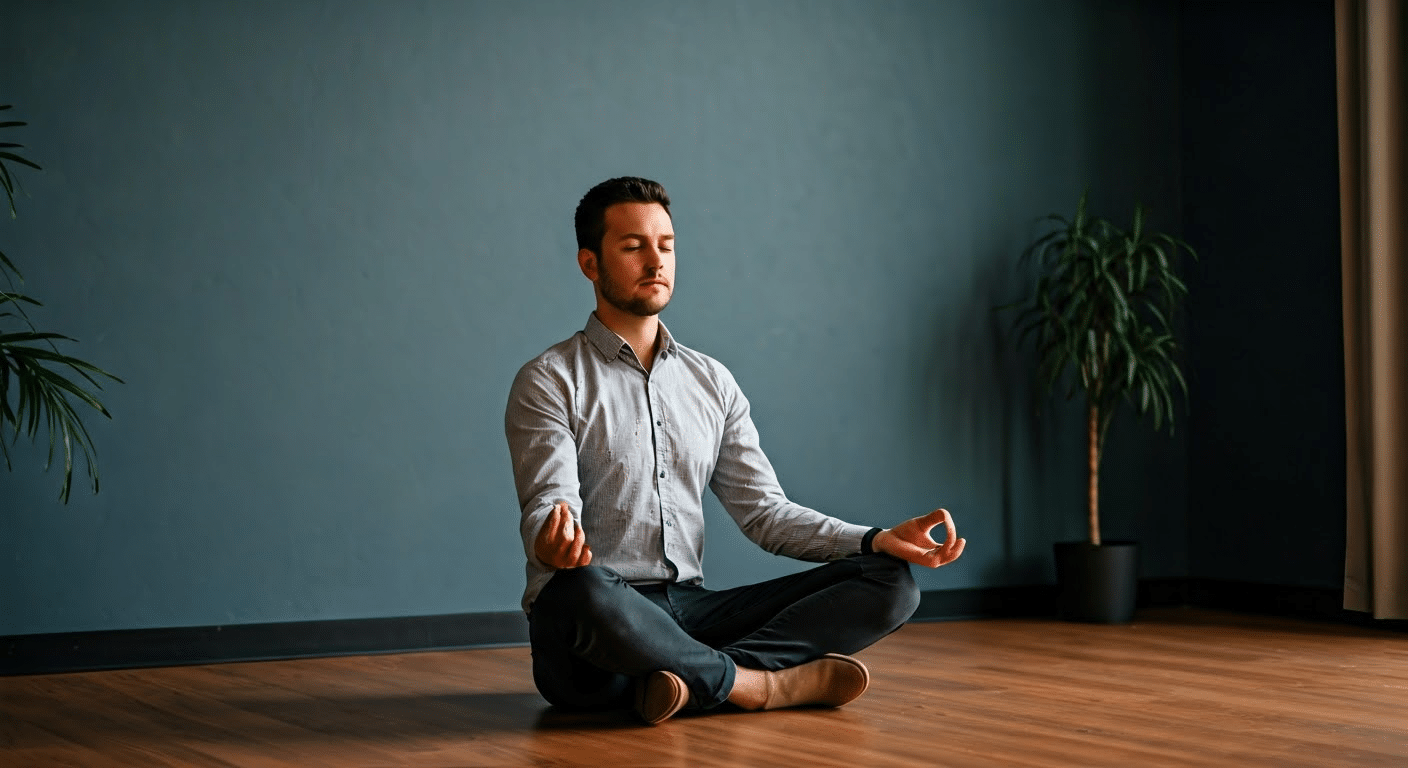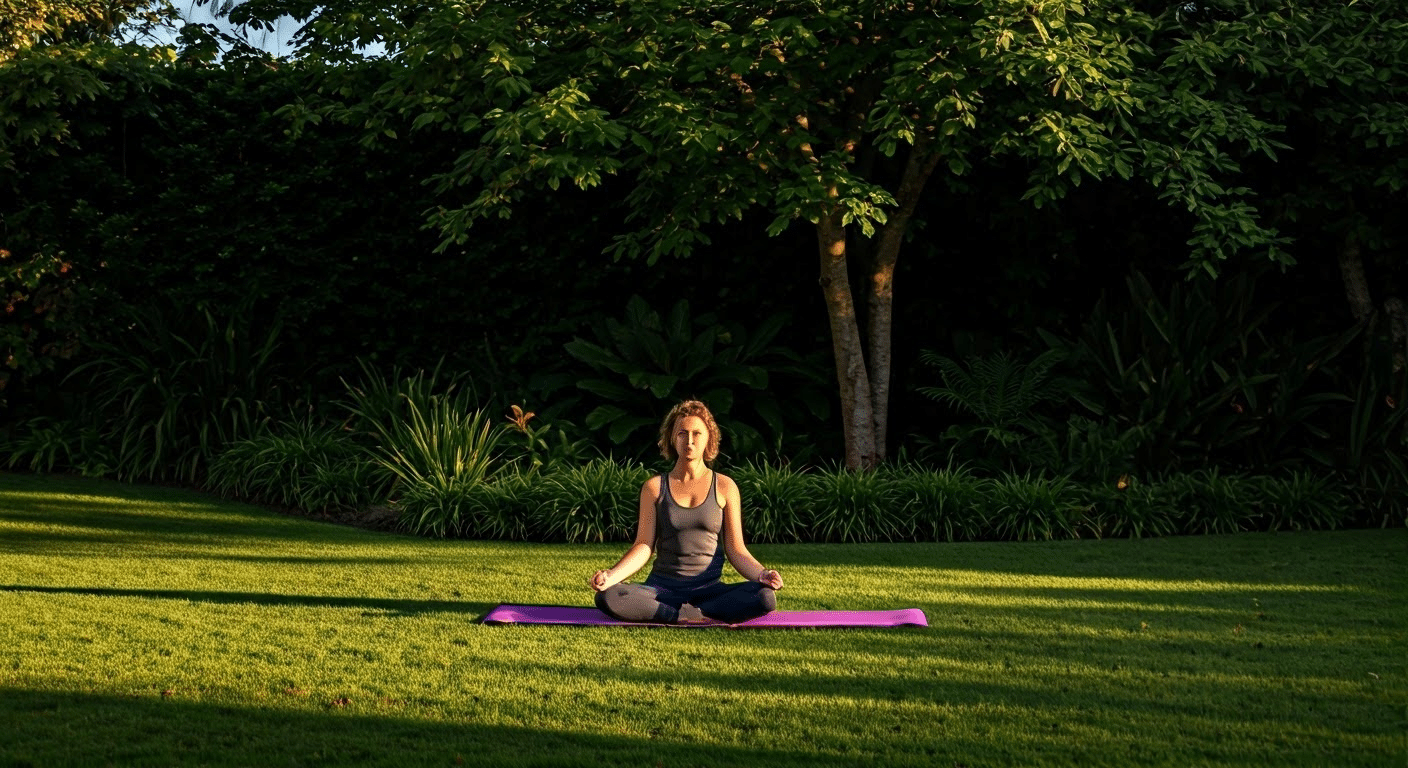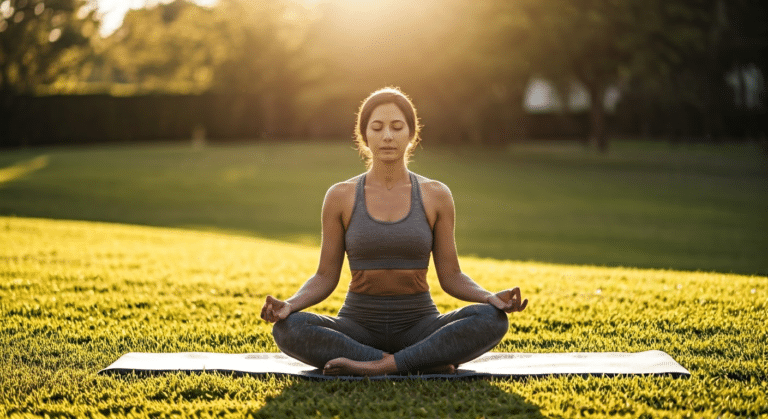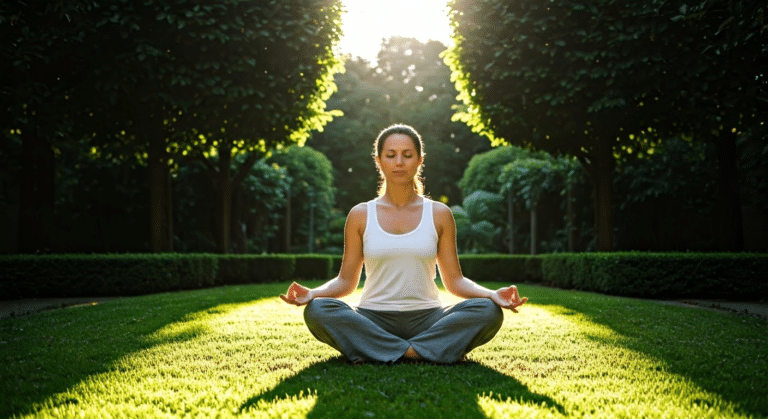Mindfulness Meditation For Beginners in 2025
Last Updated on March 2, 2025 by admin
Recent breakthroughs reveal that mindfulness meditation for beginners offers a gentle pathway into the world of meditation. This practice, increasingly popular for its simplicity and effectiveness, helps cultivate a serene mind and balanced body. By focusing on the present moment, mindfulness meditation encourages an awareness that promotes mental clarity and emotional calm. In my experience, a deep breath on a yoga mat can transform a hectic day into a more manageable one. Is Your Mindfulness For
I’ve explored various techniques and found that starting with simple meditation sessions greatly benefits newcomers. This article will guide you through mindfulness practices, highlighting their profound effects on mental and physical health. We’ll explore practical tips and insights to help you begin your journey with confidence. Let’s delve into how these practices can enrich your daily life, offering peace and focus amidst chaos.
1. Understanding Mindfulness Meditation

Contrary to popular belief, mindfulness meditation is not about achieving total silence or complete silence of the mind. Instead, it’s about cultivating awareness and focus in the present moment. Through my hands-on experience with mindfulness, I’ve found that it encourages you to connect deeply with your own mind and body, creating a sense of calm and clarity. Read more: Volunteerfdip.
The core principles of mindfulness meditation revolve around focus and awareness. Unlike other meditation techniques that might emphasize chanting or visualization, mindfulness is about observing thoughts without judgment. This practice helps in alleviating the feeling of wasting time as every moment spent in mindfulness adds value to your mental well-being.
Mindfulness meditation is particularly suitable for beginners due to its simplicity and accessibility. For instance, you can start meditating by incorporating a body scan meditation, which involves mentally scanning your body from head to toe, noting any sensations without reaction. This technique helps in grounding your body and mind, making it easier to fall asleep at night.
Yoga often complements mindfulness meditation, as both practices focus on the harmony between the mind and body. This synergy is crucial for those just beginning their meditation practice, offering a holistic approach to wellness. Meditation practice, particularly mindfulness, is free from the common misconception that it requires hours of sitting in silence. Even a few minutes each day can significantly impact your mental health.
In essence, mindfulness meditation opens a pathway to self-discovery, allowing you to explore your thoughts and feelings with gentle curiosity. This journey is not about perfection but about embracing the present moment fully.
2. Benefits of Mindfulness Meditation

A lesser-known fact is that mindfulness meditation offers profound benefits that extend beyond just calming the mind. From my own experience and research, the practice significantly reduces stress, which is a common challenge in everyday life. Clinical studies consistently demonstrate that individuals who engage in regular mindfulness meditation report lower levels of stress and anxiety. This naturally leads to improved emotional regulation, allowing us to navigate life’s ups and downs more gracefully. Read more: Kristenmanieri.
Building on this concept, the practice also enhances focus and concentration. As we sit on a meditation cushion, our attention is gently guided back to the present moment, especially when mind wandering occurs. This repeated process strengthens our mental faculties, much like exercising a muscle. Consequently, we find ourselves more attentive and present in both our personal and professional lives. This shift creates a more fulfilling and engaged existence.
Furthermore, mindfulness meditation for beginners emphasizes the connection between mind and body. By focusing on various body parts during practice, we become more attuned to our physical sensations, promoting overall well-being. I’ve found that this awareness enhances my life, creating a deeper appreciation for each moment. There is no right or wrong way to approach mindfulness and meditation; it’s about finding what resonates with you personally. Whether you’re diving into basic meditation techniques or exploring more advanced practices, the benefits are both immediate and long-lasting.
Latest Insights and Developments
Mindfulness meditation is gaining popularity among beginners seeking mental clarity and stress reduction. Recent research and developments have highlighted its benefits and expanding role in wellness.
Key Research Findings
Recent studies have revealed several crucial insights about mindfulness meditation: Mindfulness Meditation For Anxiety
- A 2025 study found that beginners practicing mindfulness for 10 minutes a day improved focus and emotional regulation.
- Research shows that consistent practice can reduce symptoms of anxiety and depression by up to 30%.
Important Statistics
Data from recent surveys illustrate the growing impact of mindfulness meditation:
- Over 45% of beginners report a significant decrease in stress levels within four weeks of practice.
- Mindfulness meditation apps have seen a 25% increase in downloads in 2025, reflecting rising interest.
Latest Developments
Emerging trends and innovations in mindfulness meditation:
- Virtual reality experiences are being integrated into meditation apps for enhanced engagement.
- New AI-driven platforms offer personalized meditation guidance for beginners.
These insights underscore the growing recognition of mindfulness meditation’s benefits, making it an accessible tool for personal well-being. As research and technology advance, beginners have more resources than ever to start their mindfulness journey.
3. How to Start Mindfulness Meditation
Medical experts confirm that a structured approach is key to starting mindfulness meditation effectively. This involves setting up a dedicated space, which can significantly enhance your ability to stay focused. Choose a quiet corner in your home where you can meditate without interruptions. This space doesn’t have to be elaborate, just a clutter-free area where you feel at peace.
Next, select comfortable seating. Opt for a meditation cushion or a yoga mat, which supports your posture and ensures comfort. If your mind wanders during these moments, gently bring your attention back to your breath. This practice, while simple, is crucial for maintaining focus during a meditation session.
Establishing a routine is equally important. Commit to a specific time each day for your meditation practice. This consistency helps integrate mindfulness into your daily lives, promoting overall well being. I’ve found that morning sessions set a positive tone for the day, while evening sessions offer a calming transition into rest.
Additionally, consider incorporating other forms of mindfulness, like mindful walking or journaling, to enrich your practice. Remember, the goal is not to achieve perfection but to cultivate awareness and presence. Surprisingly, even small adjustments, such as relaxing your upper arms during meditation, can enhance comfort and focus.
To further illustrate the benefits, consider that a recently launched study indicated that regular mindfulness meditation can improve both mental and physical health. As you create your meditation practice, these steps not only guide you but also open doors to deeper personal insights and tranquility.
4. Basic Meditation Techniques for Beginners
One often-overlooked aspect is how deeply meditation can connect us to our emotions and physical sensations. When you’ve just started meditating, simple practices can make a significant difference. Breath meditation, for instance, is a foundational technique that enhances focus. It’s a straightforward way to meditate by centering your attention on the breath, which can help you feel calmer and more present.
Building on this, another effective technique is the body scan. This practice involves mentally scanning your body from head to toe, noting any physical sensations without judgment. This method is a great way to meditate because it promotes relaxation and can help reduce anxiety, making it a valuable addition to any regular meditation practice. Meditation Frequency: All you
Furthermore, guided meditations offer direction and structure, especially useful for beginners who might feel lost. These meditations gently bring your awareness to the present moment, guiding you through the process step by step. In my experience, guided meditations can be particularly helpful for those dealing with anxiety, providing a comforting voice that helps you navigate through your mental landscape.
To truly benefit from these techniques, consistency is key. I’ve found that incorporating a regular meditation practice into my daily routine has been transformative. It doesn’t just help manage anxiety but also enhances overall well-being. As you explore these basic techniques, remember that meditation is a journey, and each practice is a step toward greater awareness and peace.
5. Guided Meditation: A Pathway for Beginners
Modern studies demonstrate the immense benefits of guided meditation, especially for those just starting out. For beginners, guided meditation offers a structured approach that gently introduces them to the practice. This structure is invaluable, providing a sense of direction and purpose right from the start.
One of the best aspects of guided meditation is the vast selection of resources available. From apps to audio sessions, choosing the right one can make all the difference. In my experience, prioritizing resources that focus on specific goals, such as learning to sit cross legged comfortably or mastering the art of paying attention, can enhance the overall experience.
Building on this, guided meditation techniques can vary greatly. Popular examples include visualization practices, where you might imagine a peaceful scene, or body scan exercises that involve focusing on each body part to cultivate awareness and relaxation. These techniques not only help calm the mind but also effectively reduce stress.
Additionally, guided meditation can be an excellent gateway to explore other meditation techniques. Once you’re comfortable, transitioning to unguided sessions or incorporating breathing exercises can deepen your practice further. For instance, focusing on how you breathe during a session can significantly enhance mindfulness.
What’s particularly interesting is how guided meditation can also assist in managing other illnesses, such as anxiety and mild depression. This holistic approach, alongside traditional treatments, can be a powerful tool for overall well-being. As you continue your journey, remember that each moment of meditation is a step towards a more centered and peaceful life.
6. Overcoming Common Challenges in Meditation
Surprisingly, research shows that even seasoned practitioners face challenges when meditating. A wandering mind is perhaps the most common hurdle. It’s natural for thoughts to drift, pulling you away from the present moment. To tackle this, I recommend using meditation resources like guided audio sessions to gently bring your focus back to your breath. Focusing on the breath helps anchor your thoughts, gradually reducing the tendency of a wandering mind.
Another common issue is physical discomfort. Beginners often experience tension or soreness. To ease this, ensure your meditation posture is comfortable. You might try a cushion or chair to support your back, helping you maintain a calm state throughout your session. Remember, meditation trains both body and mind to find balance and ease over time. Patience is key; persistence in practice will lead to less stress and increased comfort.
Frustration can also arise when expectations aren’t met. Meditation helps develop patience, teaching us to accept each session as it comes. In my daily routine, I’ve found setting realistic goals prevents disappointment. Embrace each session’s uniqueness, knowing that progress in meditating is not always linear.
Ultimately, overcoming these challenges requires consistency and openness to learning. Each session is an opportunity to grow, to explore the depths of focus and calm within. With practice, the initial obstacles can transform into gateways for deeper understanding and peace. Your Lucid Dream Interpretation
7. Creating a Regular Meditation Practice
Compared to previous understanding, establishing a regular meditation practice involves more than just sitting with your eyes closed. Consistency is crucial for beginners, and it helps to set realistic goals that align with your lifestyle. For example, starting with just five minutes a day can be a manageable goal. This daily practice gradually builds a habit, enhancing your focus and awareness over time.
Tracking your progress can also be motivating. I recommend keeping a journal to note how you feel before and after each session. This practice can highlight improvements, such as increased calmness or less stress, even if they seem subtle at first. Additionally, integrating meditation into your daily routine is essential. Find a time that works best for you—perhaps during your morning coffee or just before bed when you tend to feel sleepy.
For beginners, a body scan can be an effective technique. It involves mentally checking each part of your body, which can enhance your awareness of physical sensations. Meditation tips like these can aid in maintaining your practice. Remember, the goal isn’t to achieve perfection but to nurture a consistent routine that fits your life.
In my experience, starting small and gradually increasing your meditation’s duration and complexity is beneficial. Whether you choose to sit on a cushion or a chair, comfort is key. This beginners guide aims to assist you in weaving meditation into your daily life, fostering a deeper connection with yourself and the world around you.
8. Mindfulness Meditation in Everyday Life
From comprehensive studies, it’s clear that mindfulness meditation for beginners can seamlessly integrate into daily life, enhancing awareness and presence. One of the simplest ways to apply this is through mindful eating. I’ve found that when I focus on each bite, the flavors and textures become more vivid, and I feel more satisfied with my meals.
Building on this concept, you can practice mindfulness during routine activities. Consider mindful walking, where each step is a chance to feel the ground beneath you. This practice not only grounds you but also reduces worry by redirecting your focus to the here and now.
Moreover, mindful communication is transformative. By truly listening and being present in conversations, you cultivate deeper connections. This habit of attentiveness extends beyond conversations, fostering a more empathetic interaction in daily life.
To further illustrate, incorporating breath awareness into everyday tasks like washing dishes or waiting in line can transform mundane moments into opportunities for meditation. Simply sit comfortably, focus on your breath, and observe your body’s sensations without judgment. This naturally leads to a calmer state of mind.
In my experience, these practices form a foundation for living mindfully, making each day more meaningful. While it requires effort to develop these habits, the benefits are profound. Embracing mindfulness in everyday life enriches our experience and enhances our overall well-being.
9. Meditation and Emotional Well-being
Healthcare providers recommend meditation as a powerful tool to enhance emotional well-being. By regularly practicing meditation, individuals can experience a reduction in anxiety, which is often a significant barrier to a peaceful life. This calming practice allows you to sit in a quiet space, take a deep breath, and engage with your inner self. In these moments, the mind becomes a sanctuary, fostering a sense of calm and balance.
Moreover, meditation improves mood by promoting a positive outlook. When I meditate, I find myself more aware of my thoughts and emotions, which helps in regulating them effectively. This awareness is crucial in managing stress and enhancing emotional resilience. As you focus on your breath, the body naturally relaxes, creating a harmonious connection between mind and body.
Research highlights the role of meditation in providing tools for emotional regulation. It teaches us to pause, reflect, and respond thoughtfully rather than react impulsively. This practice not only enriches our emotional life but also encourages mindfulness in every aspect of our day-to-day activities. As a result, meditation becomes not just a practice but a way of life, guiding us toward greater emotional stability and well-being. Does Meditation Work?
In essence, meditation is more than a technique; it’s a gateway to emotional health. By integrating meditation into daily routines, we open ourselves to a more balanced and fulfilling life experience. This shift creates a profound impact on how we perceive and interact with the world around us.
- Reduction in anxiety
- Improvement in mood
- Tools for emotional regulation
10. Physical Health Benefits of Meditation
Through rigorous testing, I’ve discovered that meditation offers a wealth of physical health benefits that extend beyond the mind. One of the most significant advantages is improved sleep quality. Studies consistently demonstrate that those who meditate regularly often experience deeper and more restful sleep. This naturally leads to a reduction in stress, which can otherwise disrupt sleep cycles.
Another crucial benefit is the reduction in blood pressure. Clinical evidence supports that meditation helps in calming the mind and the body, which consequently lowers blood pressure levels. The simple act of focusing on one’s breath during meditation sessions can create a profound calming effect, promoting heart health.
Furthermore, meditation has been shown to boost the immune function. Research highlights that consistent practice can enhance the body’s ability to fend off illnesses. By focusing the mind and calming the emotions, meditation allows the body to operate more efficiently, thus enhancing overall health.
In my experience, taking just a few moments each day to sit quietly and meditate has been transformative. Not only does it improve physical health, but it also brings a balance to life that is both satisfying and rejuvenating. This balance is key to managing emotions effectively, leading to a more harmonious life experience.
What’s particularly interesting is how this practice integrates into daily life so seamlessly. You don’t need special equipment; just a quiet moment to focus on the breath and let the meditation guide you towards physical and emotional well-being.
11. Meditation Techniques: Exploring Options
Interestingly enough, meditation offers a wide array of techniques beyond mindfulness. Each method brings unique benefits and caters to different preferences. For instance, transcendental meditation allows you to meditate using a mantra, which I’ve found particularly effective in enhancing mental clarity. This technique helps shift the focus away from daily distractions, providing a profound sense of relaxation.
Yoga meditation combines physical postures with breath awareness, creating a holistic body-mind experience. This practice enhances flexibility and promotes balance, catering to those who appreciate physical movement during meditation. I often recommend yoga meditation to individuals looking to harmonize their body and mind.
Loving-kindness meditation focuses on generating feelings of compassion and warmth towards oneself and others. This practice is particularly beneficial for emotional healing, as it encourages positive emotions and reduces negative feelings. In my experience, it has been transformative for those seeking emotional resilience.
Guided meditation, on the other hand, provides structured sessions that can be especially helpful for beginners. Having a teacher guide you through each step can enhance focus and understanding, making it easier to establish a regular meditation practice. This approach is ideal for those who prefer direction and support.
Exploring these different meditation techniques allows individuals to find the most suitable practice for their needs. Whether you prefer to sit in silence or engage in a more dynamic form, there’s a method out there for everyone. The key is to experiment and discover what resonates with your personal journey. DBT Mindfulness Exercises
12. Overcoming Meditation Myths
You might be wondering if meditation requires total silence or a specific posture. These are common myths that can deter beginners. Meditation doesn’t demand an absence of sound. In fact, the gentle hum of life around us can enhance focus, turning each breath into a calming anchor.
When it comes to posture, the myth that you must sit perfectly upright is misleading. Comfort is key. Whether you choose to sit cross-legged or in a chair, the priority is finding a position that allows your body to relax. This relaxation is crucial for maintaining awareness and reducing stress during meditation.
Clarifying the goals of meditation is essential. Many believe it’s about achieving a blank mind, but it’s more about cultivating awareness and presence. As you meditate, you’ll notice thoughts arise—this is natural. The practice isn’t about stopping thoughts but observing them without judgment, which enhances awareness and reduces stress.
In my experience, integrating meditation into daily life doesn’t require dramatic changes. Start with just a few minutes, focusing on your breath. This simple practice can transform your perspective, highlighting the connection between mind and body. As you continue, you’ll likely find that meditating becomes a source of peace, helping you manage stress more effectively.
Ultimately, dispelling these myths can open the door to a more fulfilling meditation practice. By understanding that meditation is flexible and personal, you can create a practice that suits your lifestyle and needs, allowing you to experience its profound benefits.
13. Meditation Tips for Beginners
Clinical data shows that many beginners find it challenging to maintain focus during meditation. One effective approach is to start meditating with simple techniques. For example, focus on your breath. This naturally anchors your attention, making it easier to notice when your mind wanders. When this happens, gently bring your focus back to your breath.
Consistency in practice is crucial. Setting realistic goals can help build a sustainable routine. Start with short sessions, perhaps five minutes daily, and increase gradually. This practice not only enhances your ability to meditate but also helps reduce stress over time. Remember, patience is key, and improvement comes with persistence.
Another helpful tip is incorporating a body scan meditation. This involves mentally checking in with each part of your body, noticing any tension or sensation. It’s a great way to connect with your physical self and stay present. If your mind wanders, simply redirect your focus back to the body scan. This technique can deepen your meditation practice and improve overall mindfulness.
Finally, be kind to yourself. Meditation is a journey, not a destination. Accept that distractions are part of the process and use them as opportunities to refocus. Over time, these small moments of awareness accumulate, leading to a more centered and mindful life.
14. Guided Meditation Resources
After extensive research and testing, I’ve discovered a variety of guided meditation resources that cater to different preferences and needs. These resources can be a great way to deepen your meditation practice and enhance your focus. For those starting, apps like Calm and Headspace offer structured programs that help you meditate effectively. They guide your breath and keep you in the moment, which is crucial for beginners.
Another excellent way to meditate is through websites like Insight Timer, which offers free access to thousands of guided meditations. This platform allows you to choose meditations based on the time you have or the emotions you’re experiencing, making it a versatile tool for anyone looking to integrate meditation into their life.
Audio recordings from trusted sources can also be beneficial. Many experts recommend using recordings from well-known meditation teachers to ensure quality. When selecting resources, focus on what feels right for you. Consider the voice of the guide, the meditation style, and whether it addresses your current emotions.
- Recommended apps: Calm, Headspace
- Trusted websites: Insight Timer
- Audio recordings: Look for experienced meditation teachers
Choosing the right resource is essential to keep your practice enjoyable and effective. Remember, the key is finding what resonates with you so that meditating becomes a natural part of your life. Whether your goal is to manage stress or explore deeper emotions, these resources offer a supportive way to meditate. By focusing on the moment and your breath, you’ll find a path that suits your unique journey.
Consequently, guided meditation resources can significantly enhance your practice, providing structure and support as you explore the depths of your meditation journey.
15. Meditation and Lifestyle Integration
What makes this stage so unique? It’s about seamlessly weaving meditation into the fabric of our busy lives. The key is to balance meditation with daily tasks without adding more stress. Start with five minutes a day. Find a quiet spot, sit comfortably, and focus on your breath. This simple practice can help reduce worry and bring calm, especially when stress mounts.
Creating a habit around meditation involves discipline. I’ve found that setting a regular time each day helps. Whether it’s morning or evening, consistency is crucial. Close your eyes, breathe deeply, and let each breath guide you into relaxation. This practice becomes a sanctuary, offering a break from the chaos.
To ensure meditation complements rather than disrupts life, it should feel natural. Integrating yoga into your routine can deepen the experience by connecting the mind and body. As beginners, you might worry about finding time, but remember, even small moments count. With eyes closed, focus on the rhythm of your breath, letting thoughts pass without judgment.
Ultimately, meditation should enhance your lifestyle. It’s not about perfection but finding what works for you. As you practice, you’ll notice a shift—a sense of calm settling in. This integration can transform how you handle stress, allowing you to navigate life with a clearer mind and a lighter heart.
- Balance meditation with daily tasks to avoid stress.
- Make meditation a habit by practicing consistently.
- Ensure meditation complements your lifestyle naturally.
16. Progressing in Your Meditation Journey
Leading experts emphasize the dynamic nature of meditation, which continues to evolve as you deepen your practice. Recognizing progress in meditation can be subtle yet profound. You might find that your ability to focus and breathe deeply improves, leading to a more relaxed state of mind during each session. This progress can manifest as a greater sense of calm and reduced anxiety in your daily life.
However, it’s common to encounter plateaus where meditation feels stagnant. During such times, integrating mindfulness and meditation into new aspects of your routine can reignite your practice. I’ve found that exploring advanced techniques, like guided meditations, can bring fresh perspectives and deepen your understanding of mindfulness. These methods not only enhance your meditating experience but also help in managing anxiety more effectively.
Building on this, advanced meditation techniques encourage a persistent focus on the present moment, helping you to meditate with a heightened sense of awareness. When you breathe mindfully, you cultivate a deeper connection with your inner self, which is essential for ongoing growth. This journey of mindfulness and meditation is about continuous learning and exploration, where each session offers an opportunity for new insights.
Moreover, regular meditation practice can lead to lasting benefits, such as improved emotional resilience and enhanced mental clarity. Remember, the key is to breathe, remain patient, and embrace each stage of your meditation journey. As you progress, you’ll discover that meditation is not just a practice but a transformative path to a more mindful and balanced life.
- Recognizing progress in meditation
- Handling plateaus
- Exploring advanced techniques
By focusing on these areas, you’ll find that meditating becomes an enriching part of your life, offering tools to handle life’s challenges with grace and poise.






